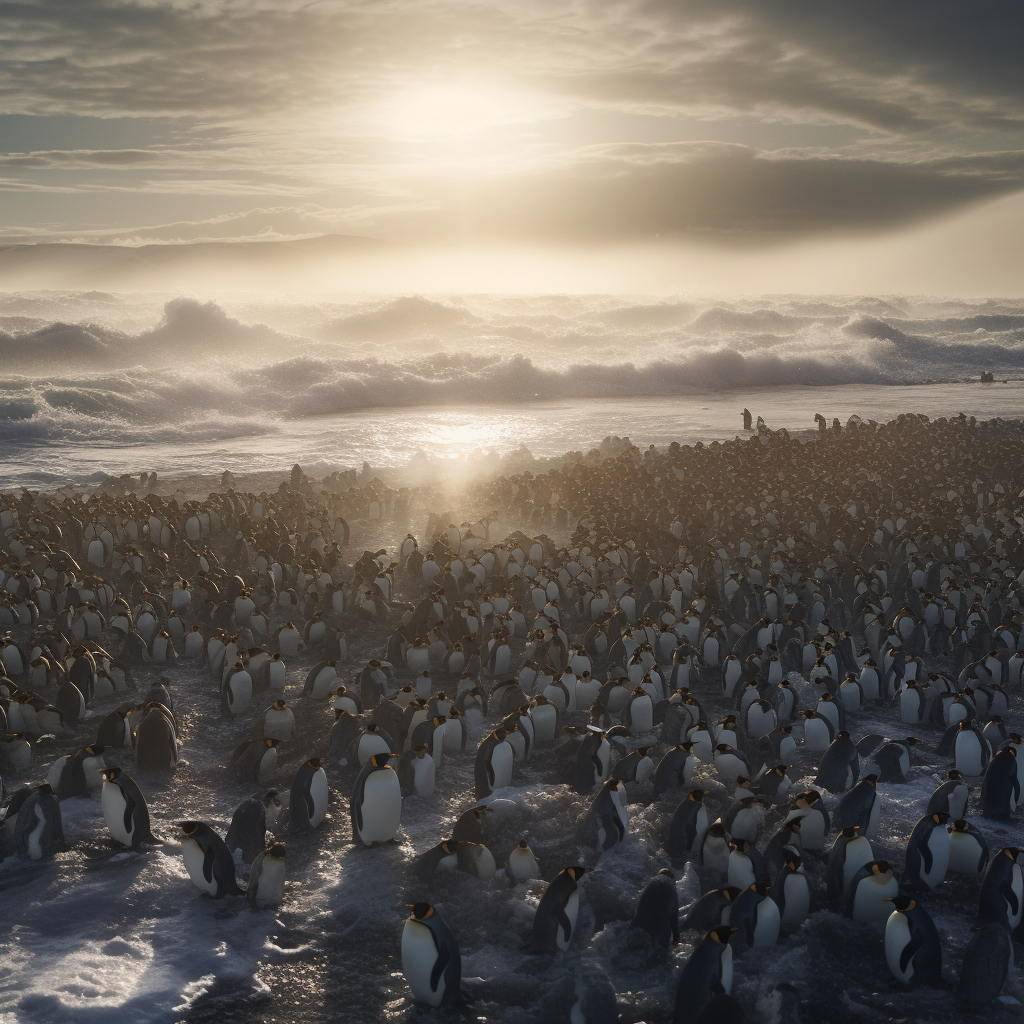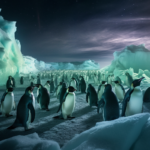Penguins are fascinating creatures that have captured the hearts of people all around the world. These flightless birds are known for their unique adaptations to the cold and harsh environments of the Southern Hemisphere, where they reside. One of the most remarkable aspects of penguins’ lives is their ability to migrate. Migration is a natural behavior observed in many animal species, and penguins are no exception. In this article, we will delve into the intriguing world of penguin migration, exploring the reasons behind their journeys, the routes they take, and the challenges they face along the way. So, let’s dive in and discover how these incredible birds navigate the vast oceans in search of food and breeding grounds.
Key Takeaways
- Penguins migrate to find food and breed in different locations.
- They travel long distances, sometimes thousands of kilometers, to reach their destination.
- Penguins use a combination of swimming and walking to migrate.
- They rely on their strong instincts and natural navigation abilities to find their way.
- Climate change and human activities can impact penguin migration patterns and survival.
Understanding Penguin Migration: An Overview
A. Defining Penguin Migration
Penguins are fascinating creatures that have captured the hearts of many. One of the most intriguing aspects of their lives is their ability to migrate. But what exactly is penguin migration? In simple terms, penguin migration refers to the seasonal movement of penguins from one place to another in search of food, breeding grounds, or better environmental conditions.
Unlike some bird species that migrate individually, penguins migrate in groups, making their journey even more remarkable. These marine birds are known for their strong sense of direction, which allows them to navigate vast distances across the ocean. Penguins are highly adaptable creatures, and their migratory habits play a crucial role in their survival.
B. The Importance of Migration for Penguins
Migration is of utmost importance for penguins, as it enables them to find suitable breeding grounds and feeding grounds. The availability of food is a significant factor that influences penguin migration. As the seasons change, the distribution of prey species in the ocean also shifts. Penguins rely on their migration instincts to locate areas rich in fish, krill, and other small marine organisms that form the core of their diet.
During the breeding season, penguins migrate to specific locations where they can establish colonies and raise their young. For example, Emperor Penguins, the largest of all penguin species, embark on an incredible journey from the open ocean to the inland breeding grounds of Antarctica. These remarkable birds can travel up to 100 kilometers (62 miles) to reach their destination.
Adélie Penguins, another well-known penguin species, also undertake long-distance migrations. They travel from their marine feeding grounds to the Antarctic coast, where they build nests and raise their chicks. These migrations can cover hundreds of kilometers, and the journey is not without its challenges.
Penguins face numerous obstacles during their migration, including harsh weather conditions, predators, and the risk of getting lost. However, their strong instincts and remarkable navigation skills help them overcome these challenges. Scientists believe that penguins use a combination of celestial cues, landmarks, and magnetic fields to guide their way.
Understanding penguin migration is crucial for conservation efforts and studying the impact of climate change on these remarkable creatures. By tracking penguin migration patterns, researchers can gain insights into their life cycle, habitat preferences, and the effects of changing environmental conditions. This knowledge is essential for developing effective conservation strategies to protect penguin populations and their ecosystems.
In conclusion, penguin migration is a remarkable phenomenon that showcases the adaptability and survival instincts of these incredible birds. Their ability to navigate vast distances, find suitable breeding and feeding grounds, and overcome various challenges is truly awe-inspiring. By studying and understanding penguin migration, we can gain valuable insights into the behavior and ecology of these fascinating creatures.
The Migratory Patterns of Different Penguin Species
A. Where Do Emperor Penguins Migrate?
Emperor penguins are known for their incredible migration journeys. These majestic birds embark on a remarkable adventure, traveling long distances to reach their breeding grounds. Unlike other penguin species, Emperor penguins do not migrate to warmer climates during the winter. Instead, they brave the harsh Antarctic winter, where temperatures can drop to -40 degrees Celsius.
Emperor penguins begin their migration journey from the open waters of the Southern Ocean. They travel inland, sometimes covering distances of up to 100 kilometers, to reach their breeding colonies. These colonies are located on the sea ice, providing the penguins with a safe and stable environment to raise their chicks.
B. The Migration of Adelie Penguins
Adelie penguins, another Antarctic species, also undertake impressive migratory journeys. These small, black and white birds travel from their breeding colonies to the open ocean during the winter months. They venture out in search of food, as the sea ice surrounding their colonies becomes too thick for them to access their feeding grounds.
Adelie penguins are known to travel long distances, sometimes up to 1,000 kilometers, in search of food. They rely on their excellent swimming abilities to navigate through the icy waters. These penguins are well-adapted to the marine environment, with streamlined bodies and strong flippers that allow them to move swiftly through the water.
C. King Penguins and Their Migratory Habits
King penguins have a slightly different migratory pattern compared to other penguin species. They breed on subantarctic islands, where they form large colonies. Unlike Emperor and Adelie penguins, King penguins do not migrate long distances during the winter. Instead, they stay relatively close to their breeding colonies.
During the breeding season, King penguins take turns incubating their eggs and caring for their chicks. Once the chicks are old enough to fend for themselves, the adults head out to sea to replenish their energy reserves. They travel to nearby feeding grounds, where they can find an abundance of fish and squid to sustain them.
D. The Unique Migration of Rockhopper Penguins
Rockhopper penguins have a distinctive appearance and migratory behavior. These small penguins with spiky yellow crests are found in the subantarctic regions. They are known for their impressive jumping skills, which they use to navigate rocky terrain.
Rockhopper penguins migrate between their breeding colonies and their feeding grounds. They travel relatively short distances, usually within a few hundred kilometers. These penguins are agile swimmers, using their strong wings to propel themselves through the water. They rely on their excellent eyesight to locate their feeding grounds, which are often rich in krill and small fish.
E. African Penguins: Where and When Do They Migrate?
African penguins, also known as jackass penguins, are found along the coastlines of South Africa and Namibia. These penguins have a unique migration pattern compared to their Antarctic counterparts. They do not migrate long distances but rather move within their local region in search of food.
During the breeding season, African penguins establish colonies on rocky shores or sandy beaches. They lay their eggs in burrows or nests made of guano. After the breeding season, they disperse along the coast, traveling short distances to find suitable feeding grounds. They rely on the rich marine ecosystem of the Benguela Current, which provides them with an abundance of fish and squid.
F. Macaroni Penguins and Their Migratory Journey
Macaroni penguins, named for their distinctive yellow crests, are found in the subantarctic and Antarctic regions. These penguins undertake extensive migratory journeys, traveling long distances to reach their breeding colonies.
Macaroni penguins migrate from their feeding grounds in the open ocean to their breeding colonies on subantarctic islands. They can travel up to 6,000 kilometers during their migration, navigating through the icy waters of the Southern Ocean. These penguins are highly adaptable and can withstand the harsh conditions of the Antarctic region.
In conclusion, penguins exhibit a variety of migratory patterns depending on their species and habitat. From the long-distance journeys of Emperor and Macaroni penguins to the more localized movements of Adelie, King, Rockhopper, and African penguins, each species has adapted to survive and thrive in their respective environments. Understanding these migratory habits is crucial for conservation efforts and ensuring the continued survival of these remarkable birds.
The Mechanics of Penguin Movement

Penguins are fascinating creatures known for their unique way of getting around. Whether on land or in water, these birds have developed remarkable adaptations that allow them to move with efficiency and grace. In this section, we will explore the mechanics of penguin movement, including how they navigate on land, their speed, agility in water, and their ability to traverse icy terrain.
A. How Do Penguins Move on Land?
When it comes to moving on land, penguins may not be the most graceful creatures. However, they have evolved to be highly efficient walkers. Their bodies are streamlined, with short legs and webbed feet, which aid in propulsion and balance. Penguins waddle from side to side, using their flippers to maintain stability and momentum. This unique walking style helps them conserve energy and navigate the rugged terrain of their habitat.
B. The Speed of Penguins: How Fast Do They Move?
While penguins may appear slow and clumsy on land, they can actually move quite swiftly. The speed at which penguins move varies depending on the species and the purpose of their movement. For example, during their breeding season, Emperor Penguins can travel up to 100 kilometers (62 miles) inland to reach their nesting sites. This incredible journey can take several weeks and requires a lot of energy. On average, penguins can walk at a speed of about 2.5 kilometers (1.5 miles) per hour, which may not seem fast to us, but is quite impressive considering their short legs and bulky bodies.
C. The Aquatic Agility: How Do Penguins Move So Fast in Water?
When it comes to swimming, penguins are in their element. They are highly adapted to life in the water and are incredibly agile swimmers. Their streamlined bodies, strong flippers, and dense feathers provide excellent buoyancy and hydrodynamic efficiency. Penguins use their flippers to propel themselves through the water, while their webbed feet act as rudders for steering. They can reach speeds of up to 20 kilometers (12 miles) per hour, allowing them to chase prey and evade predators with ease. Their ability to dive deep into the ocean also enables them to access food sources that other marine birds cannot reach.
D. Penguin Movement Across Ice: A Survival Skill
In addition to their prowess on land and in water, penguins have also developed unique skills for navigating icy terrain. Many penguin species inhabit regions with extensive ice coverage, such as the Antarctic. To move across the ice, penguins use a combination of sliding, belly flopping, and tobogganing. They propel themselves forward by pushing with their feet and sliding on their bellies, reducing friction and conserving energy. This method of movement allows them to cover long distances quickly and efficiently.
Penguins’ ability to adapt to different environments and move with such efficiency is truly remarkable. Whether waddling on land, swimming in the ocean, or sliding across ice, these birds have honed their movements to perfection. Understanding the mechanics of penguin movement not only provides insight into their fascinating behavior but also highlights their incredible survival skills in some of the harshest environments on Earth.
The Evolution of Penguin Migration
A. Tracing Back: How Did Penguins Move?
Penguins are fascinating creatures that have evolved unique ways of moving and surviving in their environment. While they are known for their distinctive waddling walk on land, their ability to navigate through water is equally impressive. But how did penguins develop these remarkable movement patterns?
The ancestors of penguins were actually flying birds. Over time, these birds gradually adapted to life in the water, losing their ability to fly but gaining exceptional swimming skills. This transition from flying to swimming allowed penguins to explore new territories and find abundant food sources in the ocean.
B. The Journey to Antarctica: When Did Penguins Migrate Here?
Antarctica is now synonymous with penguins, but it wasn’t always their primary habitat. The migration of penguins to Antarctica is a remarkable story of adaptation and survival. It is believed that penguins began their journey to this icy continent around 40 million years ago.
At the beginning of their migration, penguins were not the iconic Emperor or Adélie Penguins we know today. Instead, they were smaller and more primitive species. As the climate cooled and the Antarctic region became more suitable for their survival, penguins gradually migrated to this inhospitable land.
C. Evolutionary Adaptations in Penguin Movement
The migration of penguins to Antarctica brought about significant evolutionary changes in their movement patterns. These adaptations allowed them to thrive in the harsh conditions of the region and navigate the vast ocean.
-
Streamlined Bodies: Penguins have evolved streamlined bodies, which minimize drag as they swim through the water. Their torpedo-shaped bodies, combined with strong flippers, enable them to move swiftly and efficiently, reaching speeds of up to 20 miles per hour.
-
Webbed Feet: Penguins’ webbed feet act as powerful paddles, propelling them through the water with precision and control. This adaptation helps them maneuver through the ocean currents and catch their prey.
-
Countershading: Penguins have a unique coloration known as countershading. Their dark backs blend with the depths of the ocean, while their white bellies camouflage them from predators swimming below. This adaptation helps them remain inconspicuous and avoid detection.
-
Diving Abilities: Penguins are exceptional divers, capable of descending to great depths in search of food. They have adapted to hold their breath for extended periods, with some species diving as deep as 1,700 feet. These diving abilities allow them to access food sources that other marine birds cannot reach.
-
Internal Navigation: Penguins possess an innate sense of direction, allowing them to navigate vast distances across the ocean. They use a combination of visual cues, such as the position of the sun and stars, and the Earth’s magnetic field to guide their migration.
The evolution of penguin movement and migration is a testament to their remarkable adaptability and survival instincts. These fascinating creatures have conquered the challenges of the Antarctic environment, making it their home and thriving in one of the harshest regions on Earth.
The Reasons Behind Penguin Migration

Penguins are fascinating creatures that capture our imagination with their unique behaviors and adaptations. One of the most intriguing aspects of penguins is their migration patterns. In this section, we will explore the reasons behind penguin migration and delve into the biological, breeding, and environmental factors that drive these incredible journeys.
A. Why Do Penguins Migrate: The Biological Perspective
Migration is a natural instinct for many animals, and penguins are no exception. But why do these flightless birds embark on such long and arduous journeys? The answer lies in their need to find food and ensure their survival.
Penguins are marine birds, and their primary food source is found in the ocean. However, the availability of food can vary depending on the season and location. To overcome this challenge, penguins migrate to areas where food is abundant. By moving to different regions, they can access a consistent supply of fish, squid, and krill.
B. The Breeding Factor: Why Do Penguins Migrate to Breed?
Breeding is another significant factor that drives penguins to migrate. Different penguin species have specific breeding seasons, and they migrate to specific locations to find suitable mates and establish colonies.
Emperor Penguins, for example, undertake an incredible journey to their breeding grounds in the Antarctic. These majestic birds can travel up to 100 kilometers (62 miles) inland, enduring harsh conditions to reach their destination. Once they arrive, they form large colonies and engage in courtship rituals before laying their eggs.
Adélie Penguins also exhibit migratory habits during the breeding season. They travel from their feeding grounds to the rocky shores of Antarctica, where they build nests and raise their chicks. This migration ensures that the penguins have access to an ideal breeding environment, away from predators and with ample food sources nearby.
C. Adapting to Environment: How Do Penguins Convert Saltwater into Freshwater?
Penguins face a unique challenge when it comes to obtaining freshwater. Unlike other birds, they cannot drink seawater due to its high salt content. So how do they quench their thirst during their long migrations?
Penguins have evolved a remarkable adaptation to convert saltwater into freshwater. They possess special glands located near their eyes, called supraorbital glands, which filter out excess salt from their bloodstream. This salt is then excreted through their beaks or by sneezing, allowing them to maintain a healthy balance of salt and water in their bodies.
This adaptation is crucial for penguins during their migrations, as it enables them to survive in marine environments where freshwater sources are scarce. By efficiently managing their water intake, penguins can stay hydrated and continue their journey without relying on finding freshwater along the way.
In conclusion, penguin migration is driven by a combination of biological, breeding, and environmental factors. These incredible birds undertake long journeys to find food, establish breeding colonies, and adapt to their changing environments. By understanding the reasons behind penguin migration, we gain a deeper appreciation for the resilience and adaptability of these remarkable creatures.
The Distance and Timing of Penguin Migration

A. How Far Do Penguins Migrate?
Penguins are known for their incredible ability to navigate vast distances during their annual migration. While the exact distance can vary depending on the species and individual circumstances, penguins can travel significant distances in search of food and suitable breeding grounds.
One of the most remarkable examples of penguin migration is the Emperor Penguin. These majestic creatures embark on a journey that can cover up to thousands of kilometers, making it one of the longest migrations of any bird species. They travel from their breeding colonies on the Antarctic ice to the open waters of the Southern Ocean, where they find their primary food source, fish and krill.
Adélie Penguins, another species found in Antarctica, also undertake impressive migrations. They travel from their breeding colonies on the Antarctic continent to the edge of the pack ice, where they can find abundant food. This journey can span hundreds of kilometers, as they navigate through icy waters in search of their preferred prey.
Other penguin species, such as the Gentoo and Chinstrap Penguins, have shorter migration distances compared to their Emperor and Adélie counterparts. They typically move from their breeding colonies on the Antarctic Peninsula to nearby islands or coastal areas, where they can find suitable feeding grounds.
B. When Do Penguins Migrate: Understanding the Timing
Penguin migration is closely tied to the changing seasons and the availability of food. Penguins embark on their migratory journeys when the conditions in their current location become unfavorable or when their preferred food sources become scarce.
In the Southern Hemisphere, where most penguin species reside, the migration typically occurs during the spring and summer months. This timing aligns with the breeding season, as penguins need to find suitable nesting sites and establish their territories before laying eggs.
The migration begins when the sea ice starts to break up, signaling the arrival of warmer temperatures. Penguins rely on open water to access their marine feeding grounds, where they can find an abundance of fish and krill. As the ice retreats, penguins make their way towards the open ocean, navigating through the icy waters with remarkable precision.
Once they reach their feeding grounds, penguins spend several months fattening themselves up, preparing for the breeding season ahead. They dive into the depths of the ocean, hunting for food and building up their energy reserves. This period of feeding is crucial for their survival and the successful raising of their chicks.
As the summer season comes to an end, and the temperatures start to drop, penguins begin their return journey to their breeding colonies. They navigate back to their original nesting sites, often using landmarks and their exceptional sense of direction to find their way. Upon arrival, they reunite with their mates and prepare for the next breeding season.
In conclusion, penguin migration is an awe-inspiring phenomenon that showcases the incredible adaptability and survival instincts of these marine birds. From the vast distances covered by Emperor Penguins to the shorter journeys of other species, penguins undertake migrations to ensure their survival and the continuation of their species. Understanding the timing and distance of penguin migration provides valuable insights into their behavior and the challenges they face in their ever-changing environment.
Conclusion
In conclusion, penguins are fascinating creatures that have developed unique adaptations to survive in their harsh environments. Migration is an essential part of their life cycle, allowing them to find food, breed, and avoid extreme weather conditions. Penguins navigate long distances using a combination of swimming and walking, relying on their excellent sense of direction and the Earth’s magnetic field. They form strong social bonds within their colonies and work together to overcome the challenges of migration. Whether it’s the emperor penguins’ epic journey or the gentoo penguins’ shorter trips, these remarkable birds continue to captivate us with their incredible migratory feats. So, the next time you see a penguin waddling along the icy shores, remember the incredible journey it has undertaken to be there.
Frequently Asked Questions
Q1: Where do penguins migrate?
Penguins migrate to different locations depending on their species. For example, Emperor Penguins migrate across the Antarctic ice to their breeding colonies, while Adélie Penguins migrate north to feeding grounds during the Antarctic winter.
Q2: How fast do penguins move?
The speed of penguins varies by species and whether they are on land or in water. On land, they typically waddle at a speed of 1-2 km/h. In water, they are much faster, with speeds up to 20 km/h.
Q3: When do penguins move?
Penguins move or migrate primarily during the breeding season. The timing of this varies by species. For example, Emperor Penguins start their migration in March, while Adélie Penguins migrate in April.
Q4: How do penguins move so fast in water?
Penguins are built for speed in water. Their streamlined bodies, powerful flippers, and strong tail help them to swim quickly and efficiently. They also have a layer of air trapped in their feathers, which reduces friction and increases buoyancy.
Q5: How do Adélie penguins move?
Adélie Penguins move by walking or tobogganing on their bellies on land. In water, they are excellent swimmers, using their flippers for propulsion and their feet and tail for steering.
Q6: Why do Rockhopper penguins migrate?
Rockhopper Penguins migrate to find food and to breed. They often travel long distances from their feeding grounds to their breeding colonies.
Q7: When do King Penguins migrate?
King Penguins do not have a specific migration season. Instead, they spend most of their lives at sea, coming ashore only to molt and breed.
Q8: How do penguins migrate?
Penguins migrate by swimming in the ocean or walking on ice. They use their keen sense of direction and possibly the Earth’s magnetic field to navigate.
Q9: Why do penguins migrate?
Penguins migrate for several reasons, including to breed, to molt, and to find food. The migration allows them to take advantage of different habitats at different times of the year.
Q10: How far do penguins migrate?
The migration distance varies greatly among penguin species. Some, like the Emperor Penguins, may travel up to 100 km across the ice to reach their breeding colonies. Others, like the Magellanic Penguins, may swim over 1,000 km to reach their feeding grounds.




